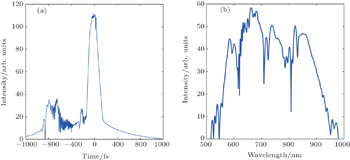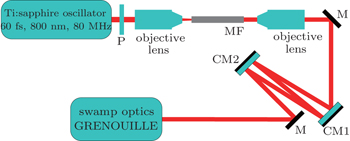† Corresponding author. E-mail:
Supercontinuum generation and compression in a length of 50-mm photonic crystal fiber with pulse of nanojoule energy are investigated theoretically and experimentally. Chirped mirror pair is used for dispersion compensation and pulse compression. Pulse characteristics are measured by frequency-resolved optical gating. And 19-fs pulse is generated.
Generation of femtosecond laser pulses is highly important in time-resolved studies of fundamental processes in physics, chemistry and biology. Various techniques for generating of few-cycle pulses were proposed based on the direct generation from the laser or employing parametric processes.[1–3] Ultrashort laser amplifiers can easily provide pulse energies in millijoule level but with pulse durations longer than several tens of femtoseconds. External compression of supercontinuum (SC) is another effective way to generate ultrashort pulse.[4] The advantages of this approach are the preserving of a single pulse in the time domain, perfect temporal coherence and spectral properties suitable for efficient external recompression. External compression of SC generated in 1.7-mm piece of all-normal dispersion photonic crystal fiber (PCF) allows producing high-quality sub-two cycle pulses.[5] Jocher et al. demonstrated nonlinear compression in a solid-core PCF, and pulse shortening by more than one order of magnitude to 23-fs pulses was achieved with chirped mirror compression.[6] Pulse with few-cycle duration could be achieved through gas-filled hollow core fibers and filamentation.[7–9] Planar waveguides were allowed to generate few-cycle pulses with higher energies.[10,11] Chen et al. generated pulses of 12-fs duration with 2-mJ energy.[12] Multi-octave self-compressions in a solid and dielectrics are reported.[13,14]
To compress self-phase modulation (SPM) induced SC in PCF is attractive technique due to the large achievable compression factor and high efficiency. SPM and positive group velocity dispersion in the fiber result in a spectrally broadened and temporally stretched output pulse. The phase accumulated by SPM is linear and positive in the time domain. By introducing appropriate amount of negative dispersion to the chirped pulse, a pulse substantially shorter than the original one can be obtained. The input chirps and the SC spectral widths for various pump pulse conditions in PCF were numerically investigated.[15,16] Mcconnell and Riis reported an order of magnitude reduction of the pulse width to 25 fs by using a short section of PCF.[17] Compression factors of three orders of magnitude and output pulses of 5 fs have been reported.[18]
In gas-filled hollow core fibers and filamentation pulse compression experiments, μJ or even mJ seed pulse was used. Using PCFs for SC generation was also possible with pulse of nanojoule energy at the oscillator repetition rate. 16 fs, 350-nJ pulses were generated by chirped pulse compression in fibers.[19] 5.5-fs pulses were generated by compressing a supercontinuum generated with 15-fs pulses from a Ti:sapphire oscillator in a 5-mm-long PCF, but double-chirped mirrors and active phase control method were used.[20]
In this paper, a Ti:sapphire oscillator with 60 fs at 80 MHz and a length of 50-mm PCF with zero-dispersion wavelength at 940 nm is used to generate SC. The spectral bandwidth and the transmitted average power of the SC are measured. The generated SC is stable due to low pulse energy of laser oscillator. 19-fs pulse is generated by using chirped mirrors to compensate for spectral phase of SC. Pulse characteristics are measured by frequency-resolved optical gating. Pulse traces at fiber output are obtained. Pulse shape and phase in spectral and temporal domains are shown in detail.
In order to show the spectral and temporal characteristics at the output end of the fiber, we first conduct theoretical simulation. The generalized nonlinear Schrödinger equation (GNLSE) is widely used to simulate the dynamics of supercontinuum generation and it can be written in its normalized form as[21,22]




We perform a numerical simulation on the propagation of 60-fs input pulses with a repetition rate of 80 MHz at a wavelength of 800 nm through 50 mm of a PCF with zero-dispersion wavelength at 940 nm, as this is also the case in our experiment. The other parameters are γ = 0.28 W−1·m−1, β2 = 1.830 × 10−26 s2/m, β3 = −12.1038 × 10−41 s3/m, and β4 = 9.525 × 10−56 s4/m. The simulated output pulse shape and spectrum at the end of the fiber with 50-mW input average power are shown in Figs.
 | Fig. 1. Simulated output pulse shape (a) and spectrum (b) at the end of the fiber with 50-mW input average power. |
In the following simulation, input average power is increased continuously. Figure
Schematic diagram of experiment is shown in Fig.
At low energy, the spectrum of 60-fs pulse is unchanged in the fiber. At high energy, spectral broadening is observed. Figure
 | Fig. 4. (a) SC spectra generated with different input powers; (b) SC bandwidth and output power vary with input power. |
As the pulse propagates through the fibre and the spectrum broadens, the temporal profile of the pulse also broadens. The phase accumulated by SPM in the fiber is positive in the time domain corresponding to a positive group delay dispersion (GDD) in the spectral domain. The large spectral bandwidth obtained through SPM in the fiber makes it possible to compress the pulse with CMs. A well-compressible SC and short pulse can be obtained only if the input pulse and the full spectrum of the SPM pulse are in the positive dispersion range of the fiber in order to avoid solitonic and Raman processes that can make the output incompressible. In the following compression experiment, 50 mW of input power is used to pump the fiber because of its SC in the normal dispersion region. Figure
 | Fig. 5. Measured outputs of the fiber pumped with 50-mW input power: (a) measured traces, (b) retrieved spectral intensity and spectral phase, and (c) retrieved temporal profile and temporal phase. |
The output of the fiber is collimated and passes through a CM pair to compensate for the spectral phase dispersion. In experiment, four bounces off CM are used. After passing through the CM pair, the compressed pulses are characterized by frequency-resolved optical gating. The measured trace is shown in Fig.
Supercontinuum generation in a length of 50-mm photonic crystal fiber pumped with nJ pulse is investigated theoretically and experimentally. Chirped mirror pair is used to compensate for dispersion and compress the broadened pulse. The wavelength range of compensating for dispersion of the CM pair is of 600 nm–1100 nm. The 19-fs pulse is generated.
| 1 | |
| 2 | |
| 3 | |
| 4 | |
| 5 | |
| 6 | |
| 7 | |
| 8 | |
| 9 | |
| 10 | |
| 11 | |
| 12 | |
| 13 | |
| 14 | |
| 15 | |
| 16 | |
| 17 | |
| 18 | |
| 19 | |
| 20 | |
| 21 | |
| 22 |





